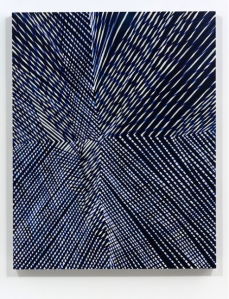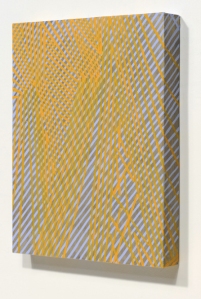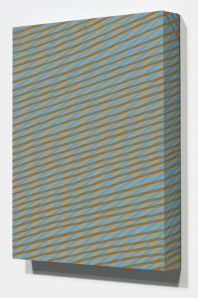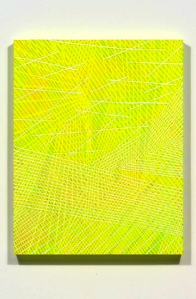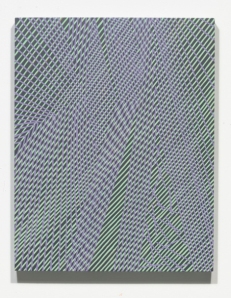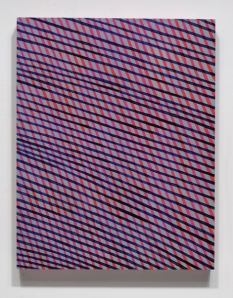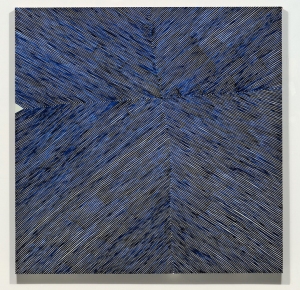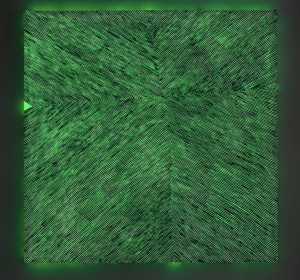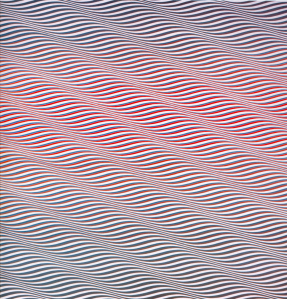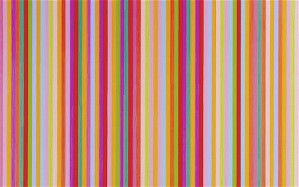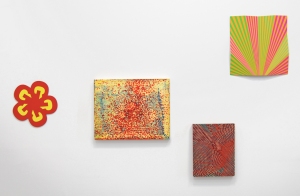Mel Prest is a San Francisco-based painter whose geometric-patterned works of charged color create such energy, they almost seem audible.
Mel’s past exhibitions include solo shows at Gregory Lind Gallery in San Francisco and B Sakara Garo in Sacramento. In October 2014 her solo show MoonBrightChime/Portmanteau will open at Galleri Urbane in Dallas. Mel is also a curator and art instructor working with numerous arts organizations in the Bay Area and throughout the world.
Articiple: The color relationships in your paintings carry so much energy—colors chase each other around the surface, reverberating in one area and then another, changing with the lighting, the viewer’s position, or even a tilt of the head. Of course color is inseparable from pattern in these pieces. The basic elements of the patterns seem simple at first—diagonal lines in parallel, intersecting and overlapping—but they get more complex the longer one looks. The patterns create alternating areas of density and openness, rest and activity, that move around the paintings. The color/pattern dynamics continually animate the paintings and undo any fixed sense of composition.
Mel: Even though I stick to color and line in painting I feel like I’m constantly being surprised by what can happen. I don’t think it shows so well in the photograph but this piece with the fluorescent yellow so bright that makes the white look gray/ beige/ violet made me really excited. Just something so simple can be sort of magical—sneaking up on me while I work.
I painted in sets of parallel lines for many years, and allowing the lines to cross and meet has made the work much more alive. I’m most excited by glitches and where the pattern starts to break down—subtle things like reloading the brush with paint or a momentary jitter become visible and affect the work immediately.
Articiple: A few years ago you shifted from oil to acrylic paint, and recently you’ve been including phosphorescent and metallic paint in some works. What has that shift meant for you?
Mel: Now, using acrylic, I feel I can do anything. I paint over things all the time and can get much stranger colors and physical effects. The glow in the dark is the most fun—it’s something that’s culturally attached to 70s black light posters and crafts, so using it feels naughty. I mean I was trained very classically and so things like metallics or fluorescents weren’t available in oil paint, or if they were they weren’t found on the “Master’s palette.” The best thing about these paints is that they shift with lighting conditions and proximity. It’s weird but I think working with acrylic has reaffirmed that nature is one of my strongest reference points—I’m looking and finding the effects of late afternoon sunlight flooding through a stand of trees by using silver, for example. It flashes at you when you walk by silver lines—goes from light to shadow instantly—like the sun going behind a cloud.
Articiple: The British artist Bridget Riley seems like a sort of artistic soul mate—your engagement with perception, your use of rhythm and variation, overlap in a lot of interesting ways. I’ve also been thinking about Ellsworth Kelly, Frank Stella, the Hard-edge work of Helen Lundeberg, even Agnes Martin, as possible influences or co-travelers. Do any of these resonate for you?
Mel: I like Ellsworth Kelly, Bridget Riley and Agnes Martin! But I was profoundly influenced by Robert Irwin—I remember walking into Dia:Chelsea and seeing his Excursus: Homage to the Square3 installation and being transported. And his book Seeing Is Forgetting the Name of the Thing One Sees. It was a book I read annually for a while and it got me super un-stuck in grad school. I like his approach—still—to his work, to phenomena, and to seeing. For me, he is the most important artist in my life.
Agnes Martin, her stubborn kindness in discussing work, and her own work, is exciting. I relate to her focus with line, and to the very direct work—no mediation with a straightedge or representation. The quality of the work being that it is what it is—how it is what you bring to it—that there is no story, only what you see. I also appreciate her writings and how they speak so directly, plus address Zen Buddhism.
I like how Ellsworth Kelly uses shapes, and also the possibility of chance, like Dada poetry, cutting and re-forming the image/work. La Combe is based on a photograph of light and shadow on a Parisian stairway that inspired a wellspring of paintings (like these and these.) This seriality that he uses—mining an image or an idea over and over again—is also something I hold close, admire and relate to.
Josef Albers’ work is thrilling too—the idea that color is always deceiving and must be in relationship (to other color) to be truly seen makes me think of color as phenomena and experiential. His book Interaction of Color reads like poetry.
I love Bridget Riley—and I so appreciate that you picked up on her in relation to me/my work. I like that much of her color relates to viewing nature and phenomena. Also that her iterations are visible—I see different versions of similar works and imagine I can see what she was seeing.
And I have really fallen for Katarina Grosse’s work lately. I feel like her work is always about to fall apart and that the color holds it together. Her large-scale pieces on erratic and non-traditional surfaces have been rolling around in my mind so much lately. I like that they feel too big to understand somehow.
I also like Mark Grotjahn, because he pushes the work till it becomes kind of ugly and also kind of like a ceremonial object—like it’s been carved or woven or somehow “built.” Also El Anatsui—how all the small objects add to a whole, creating different viewings/ perceptions based on distance; how all the small parts flow together rather than create so much pressure or feel picky. I think I could go on for a long time thinking about artists I like and for all different reasons.

Mark Grotjahn, “Untitled (Black and Cream Butterfly.” 2006, crayon and mixed media on board. 48″ x 35″.
I’ve also become interested in space or spatial relationships within 2D works that create and crush spaces. On a personal level I think this comes from the way I see, which, like many artists, is non-stereoscopic. I also see this in looking at West African fabrics from Senegal and at Japanese landscape painting. And living in San Francisco, where you are constantly looking At, Through, and Around layers of things—space contracting with fog, folded by hills and unfathomable at the ocean’s edge. Looking at nature has become a really important part of seeing—that it is constant and at the same time always changing—seeing trees that bloom, dry up, drop their leaves and those veils of leaves removed revealing an altered space.
I feel like there is a big push by artists within this space now. I’ve curated a couple of shows that dealt with this strange space between 2D and 3D, and having these contemporary artist colleagues and friends whose work relates helps me stay on my path (details here and here.)
